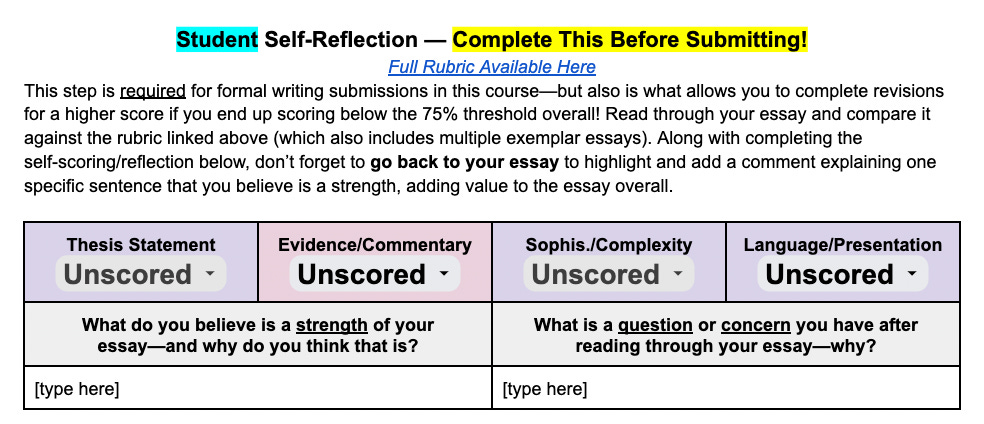Doing Writing Feedback Differently
three steps I've changed to try and make "feedback" more of an ongoing process
In our most recent episode of The Broken Copier, I made a note about a mistake from past years that I’ve made again and again: failing to create space for students to spend time with feedback on their writing.
As I said in the podcast, writing feedback far too often gets wasted by the failure to create not only space but a process to engage with that feedback—so going into this year I tried to make some significant adjustments to what the “process” looks like.
In today’s post, I wanted to highlight three of these significant shifts. Each can stand on its own, too, but I do believe that they also work together to create a better, more-holistic writing journey in the classroom, as I’m already seeing benefits and we’re not even to November quite yet!
Shift #1: Student Self-Assessing Before Submitting
Especially with the new dropdown menu feature on Google Docs, I wanted to formalize my previous years’ suggestions of “looking through the rubric before submitting” by structurally building that process into student writing in our room.
Here’s a glance of what students are expected to fill out prior to submitting any formal essay in our course:
The goal with this is two-fold:
To actively push students to go through each row of the rubric to self-assess their own writing formally in the exact way that I do in my own feedback process, giving them better awareness of the rubric that will be used to assess their writing.
To better understand how students see their own writing, including its strengths and areas of growth, and then to juxtapose that against my own feedback once I’ve completed my own process.
Especially since we’ll spend time with this rubric throughout the course, there is increasing value for student familiarity and confidence with it as a tool—so I do very much believe this investment is worthwhile before I ever lay eyes on their writing.
Shift #2: Growth Trend Anticipation Conversations
Rather than releasing feedback to students individually as I grade, I do my best to wait until a targeted class period for students to have access—and in that way, I can help frame the mindset with which they receive this data.
After we move through celebrations (including the “analysis crown” for best moment of literary commentary), we go over several trends of growth that I noticed across the essays. Here’s an example of what one of these slides looked like:
The key part about this stage: students hear about the growth trends before they receive their individualized feedback. In past years, I might have gone over “trends” but almost always after they had their individual feedback already—which allowed many to tune out if it didn’t match what was on their essay.
This time? Not only did I go over five separate trends, but I then asked them to debrief in their groups about which of the trends they thought were noted on their individual essays. This made it a much more active reflection experience—and I definitely plan on structuring it this way going forward.
Shift #3: “Writing Story” Document Across the Year
The other point I am trying to remind myself as often as I can this year: students have so much going on in their lives outside of the classroom. Not only do they have 6-7 other classes, but add in extracurriculars and work and family and miscellaneous, and very quickly your classroom becomes just a fragment of their headspace.
Which is fine, I’ll add! But that makes it all the more necessary to create “glue” that makes the learning journey more cohesive and connected—so I’ve added this “Writing Story” document into our process, too, along with the other shifts above.
Here’s what this looked like for one of the students after Essay #1:
It’s pretty straightforward, actually. After reading through their essay, students reflect on their process as writers, from the moment they received their prompt to the moment they clicked submit. And then they make a focused takeaway: what do they want to remember going forward as a growth priority based on the feedback they received?
This document lives in their digital folder for the course, and we’ll circle back to it each time they get feedback on their writing throughout the year—and then we’ll end up re-reading/reflecting on the document itself and the patterns that emerge upon it as the year proceeds!
The Willingness and Need to Shift Itself for Teachers
Adding to my own reflection, I look at these first six weeks of the year and how implementing each of these new “systems” has positively impacted our classroom and I keep coming back to how necessary it is to continually seek out areas for growth as a teacher.
I fully expect to realize many areas that need adjusting over the course of this year, too, and to walk into next year with a solid list of new items to change and systems to shift.
Such is the how and such is the why of this work.
Thanks for reading, and hope your year is going well!
—Marcus





Thanks for sharing your thoughts, Marcus. As I HS teacher I feel the rush to *cover* all of my standards often supplants this important work. I appreciate your bravery in emphasizing how important it is to slow down and let students reflect on their writing. I will be trying to do more of this in my class as well. I would love to see some samples of student work.
I would love a copy of this as a template!